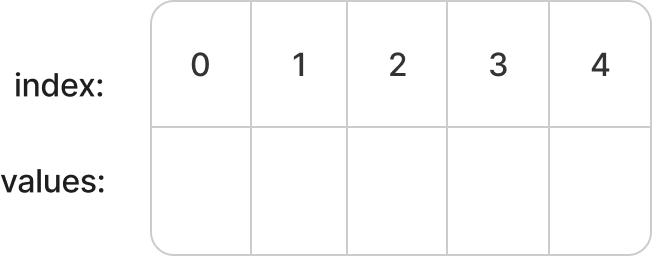COMP1511
Static arrays
Week 3 Lecture 2
functions/procedures recap
- Reusable blocks of code
- Callable multiple times
- variables within a function are scoped to that function
PI function
Would be annoying to write this every time we need to calculate!
double pi() {
double sum = 0.0;
for (int i = 0; i < 1000; i++) {
sum += (-1.0) * pow(1.0 / 2.0, i) / (i + 1);
}
return 4.0 * sum;
}
Forward declaration
int main(void) {
double calculated_pi = pi();
}
double pi() {
double sum = 0.0;
for (int i = 0; i < 1000; i++) {
sum += (-1.0) * pow(1.0 / 2.0, i) / (i + 1);
}
return 4.0 * sum;
}
^ problem! main doesn't know that pi exists yet!
Forward declaration
double pi();
int main(void) {
double calculated_pi = pi();
}
double pi() {
double sum = 0.0;
for (int i = 0; i < 1000; i++) {
sum += (-1.0) * pow(1.0 / 2.0, i) / (i + 1);
}
return 4.0 * sum;
}
^ Solved! We forward declared pi!
Quick functions recap demo
Arrays
So far, we can store a single item in each variable
What if you wanted to store many values?
Number of ice creams eaten
int day_1 = 2;
int day_2 = 3;
int day_3 = 3;
int day_4 = 5;
int day_5 = 7;
int day_6 = 1;
int day_7 = 3;
// Any day with 3 or more scoops is too much!
if (day_1 >= 3){
printf("Too much ice cream\n");
}
if (day_2 >= 3) {...
Seem repetitive?
- Many variables would clutter the program
- Many variables would not always be efficient
Data structures
- Are common structures (not structs) used to store multiples of data
- Usually (especially in COMP1511) of the same data type
- Can scale, easily storing a handful, up to thousands, or more elements of data!
Data structures in COMP1511
We will look primarily at two data structures:
- arrays (today)
linked lists (future)
These are very, very powerful data structures you will use forever
Arrays
- A collection of data, all of the same type. (homogonous)
- We have a single identifier for the entire array
- It is a random access data structure, meaning we can access any element in the array at any time
Arrays
- We can ready or modify individual elements
- It is a contiguous data structure
contigu-what?
Let's visualise arrays
Static arrays have a set size
(which you specify)

int array

- This int array will store 5 integers
- 32bit * 5 elements = 160 bits of memory used
The array declaration syntax
int ice_cream_per_day[7];

Declare + initialise
int ice_cream_per_day[7] = {3, 2, 1, 2, 1, 3, 5};
^ Note you can only do this when you declare, not later!
int ice_cream_per_day[7] = {};
^ Will initialise all elements to 0
int ice_cream_per_day[7] = {3, 2, 1, 2, 1, 3, 5};
Creates:

Accessing elements
int first_day_ice_creams = ice_cream_per_day[0];

Writing elements
ice_cream_per_day[0] = 5;

arrays 🤝 loops
The power of arrays
int ice_cream_per_day[7] = {3, 2, 1, 2, 1, 3, 5};
// read each element
ice_cream_per_day[0];
ice_cream_per_day[1];
ice_cream_per_day[2];
ice_cream_per_day[3];
ice_cream_per_day[4];
ice_cream_per_day[5];
ice_cream_per_day[6];
^ Does this look repetitive?
If only we had a way to count :(
Bad
int ice_cream_per_day[7] = {3, 2, 1, 2, 1, 3, 5};
// read each element
printf("%d\n", ice_cream_per_day[0]);
printf("%d\n", ice_cream_per_day[1]);
printf("%d\n", ice_cream_per_day[2]);
printf("%d\n", ice_cream_per_day[3]);
printf("%d\n", ice_cream_per_day[4]);
printf("%d\n", ice_cream_per_day[5]);
printf("%d\n", ice_cream_per_day[6]);
Good
int ice_cream_per_day[7] = {3, 2, 1, 2, 1, 3, 5};
int i = 0;
while (i < 7) {
printf("%d\n", ice_cream_per_day[i]);
i++; // i = i + 1;
}
Demo
Lecture Feedback
